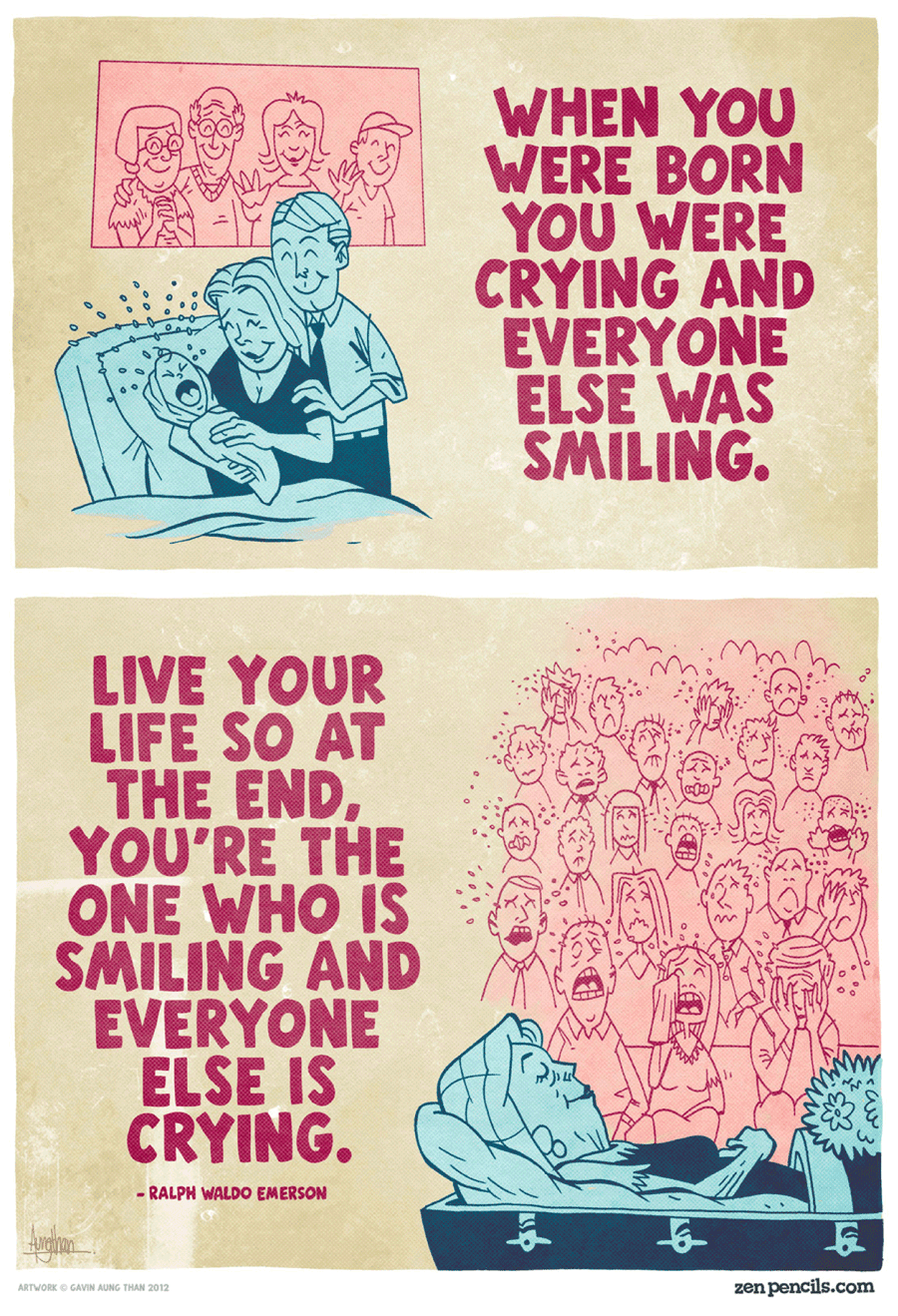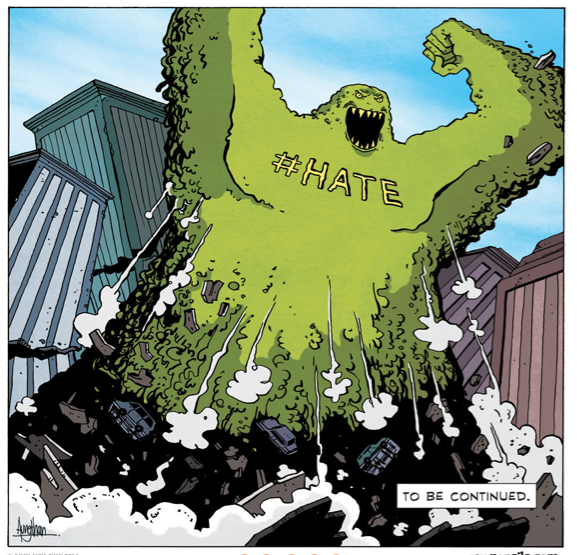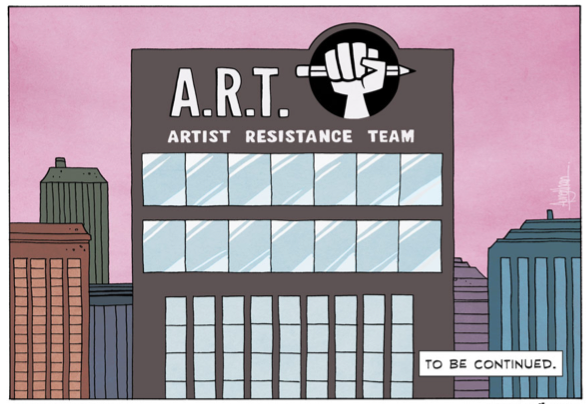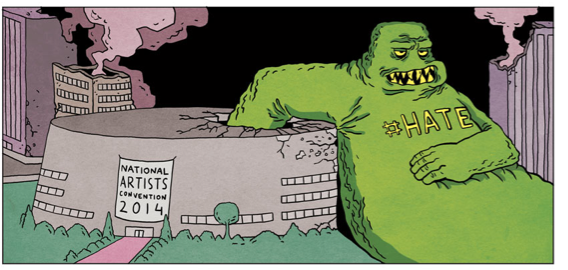Trying to figure out the exact point of Zen Pencils has not been easy. Created and written by Australia-based cartoonist Gavin Aung Than since 2012, it is at least usually a series of comics about inspirational quotes made by famous people, a sort of Chicken Soup for the Cartoonist’s Soul. With its feel good premise and emphasis on inner creativity, self-realization and the transformative power of a single out-of-context quote, it isn’t surprising that the comic series has been since its inception a hit on Facebook walls and Pinterest boards alike. Whether or not you recognize the author, if you’ve seen a comic floating around about a quote by Carl Sagan, Helen Keller, or Theodore Roosevelt, chances are you’ve seen some of Aung Than’s work. Though not all focused on unrelenting positivity, the vast majority of Zen Pencils comics are small and quickly gratifying fell-goodisms, nuggets of good vibes that find their ideal germinating ground in the digital networks of chain emails your uncle likes to send out. Yet at the same time, Zen Pencils has long had an underlying current of negative, vitriolic vein of thought running through it, expressed in angry comics on teaching, the terrors of post-graduation life, and the impact of technology on society, among others. These comics received a certain degree of notoriety for this, and, as this is the internet, a certain degree of trolling directed at Zen Pencils in general and Aung Than in particular. But it is not these initial comics that the crux of Zen Pencils’ notoriety rests on, but rather the way Aung Than responded to his critics; by creating a massive, four part comic about the evils of his interlocutors. It’s an ignominious, textbook example of how one should not respond to criticism.
The comics begin with a group of internet critics and naysayers, apparently quite literally full of shit, bursting into piles of green sludge randomly and violently. As more and more cardboard cutout cynics meet their fate this way, the green sludge begins to take form, transforming into a massive slime monster aptly titled (and with a hashtag) #hate. To counter the threat of #hate, which threatens to engulf all creativity and art in the world, an anachronistic group of artists led by one “H. Miyazaki” (copyright issues and all) gather together and, with veritably Captain Planet like gumption, form a giant mecha robot called A.R.T., emblazoned with an inspirational quote by Theodore Roosevelt, and blast off to fight the evil #hate in a climactic showdown. When they finally succeed in the comics’ thrilling conclusion, they take the entrails of their slain adversary, fly to the moon, and write the word ART on its surface as a message (and perhaps a warning) to all those who may question and criticize art.
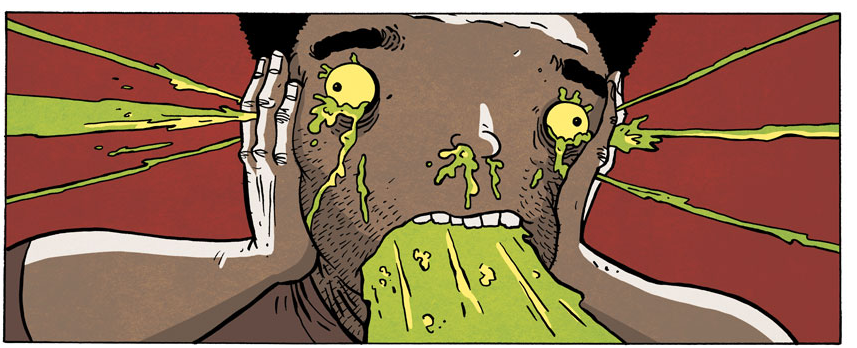
Be afraid, my fellow HU critics.
There is so much going in this bizarre four part comic, written by a man best known for writing feel-goodisms about Albert Einstein and Helen Keller, it’s difficult to know where to begin. For long-time naysayers and critics of Zen Pencils, this vociferously anti-criticism criticism is going to do little but validate their objections, that Aung Than’s work is little more than moralizing, didactic tripe that doesn’t see the world with nuance. And in doing so, of course, they will only reinforce Aung Than’s position that critics are hacks at best and slime beings at worst. So where is there to go from here? It seems all too easy to dismiss the Art vs. Hate comics as angry, senseless diatribes, long winded rants in the vein of a public meltdown, but there’s a clear form and directionality to these comics that your average twitter breakdown lacks. Aung Than has planned out these comics thoroughly, and released them successively, each within a few weeks of each other. Several weeks to a month seems a long time to hold onto the white hot rage the comics seem to project, so what is their purpose? Aung Than is clearly making a statement, however confused and angry, and this in itself seems worth at least trying to unpack. What he ends up expressing is not a rant so much as a Manichean prophecy, a declaration that we live in a world of light and dark, art and criticism, #hate and #create. And we – all of us, from immediate readers to anyone with a stake in the exploration of art itself – must take a side. Will we stand with the artists, and try to create? Or will we be swept away as critics, like so many little slime monsters?
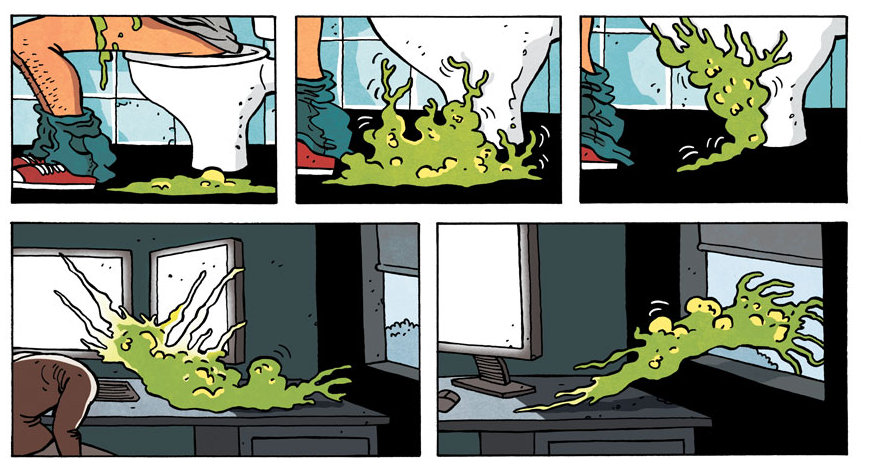
The glaring weakness in Aung Than’s dichotomy is the weakness of most dichotomies – that the binary they are predicated upon does not really exist. In writing this article, I am at least ostensibly in the position of critic, but I do not think of myself solely as such, and dedicate much of my time to my own creative endeavors. Does this make me a critic, or an artist? Am I made of slime and hate, or goodness and creativity? In truth, I and most people are a holistic mix of both. Criticism is not inimical to art; it is the molecular reaction, the most basic process, through which art of any sort is created. Art doesn’t emerge from a vacuum; it is created in response to the world, indeed as criticism towards it, and art evolves as an active process of criticisms and reassessment across decades and centuries. The Realists would not have emerged were they not critics of the Romantics; Postmodernism would never have occurred were it not for the faults present in Modernism. The moment we strip art of its critical dimension, we strip it of its ability to grow, to change, and to affect us. Art, if it is to serve a purpose, cannot simply stop being critical or subversive when we deem it so; it cannot be made for its own sake. And if you will forgive me for trying to answer the forbidden ‘what is art’ question, I would say that art exists to inform, to reflect, and to critique, and the moment it ceases in this function it is no longer art. It is something else entirely.
I hope #Hate isn’t #trending.
Is this what Aung Than wants? To strip art of its critical component and make it a dead and static thing to be hung up on a wall and endlessly gestured to? I do not think so. Zen Pencils is based on the words of wisdom spoken by some of the most notable figures in our world, and many of those figures quoted are indeed artists. Imagine a world where artists did not exist to say inspirational things! What would Zen Pencils, Hallmark, and the chain email enthusiasts of the world do?! The horror! But in all truth, in evaluating the Art vs. Hate comics, my suggestion would be for Aung Than to think back to one specific character; H(ayao) Miyazaki, his self-described biggest idol and influence. What is it about Miyazaki’s work that he appreciates the most? What does he try to emulate, and what makes it worthwhile to him? Criticism is not merely an act of negation; it is as much choosing what to keep in creative endeavors as it is figuring out what to leave behind, and what to oppose.
I do not say any of this to condescend to Aung Than or his work, for when it comes to mindlessly negative internet trolls and their detrimental impact on discourse and the creation of art, we are in total agreement. The nastiness directed towards Zen Pencils does not constitute good criticism, but the comics as a whole could stand to realize that there is more to the process of creating than empty eulogies. In raising art to a pedestal-beyond-pedestals, Zen Pencils does not enshrine art, but merely the idea of art, an empty rhetorical figure used metonymically to refer vaguely and uncritically to everything good and pure in the world. This emptying out of art, so to speak, is not a new phenomenon; defending art for art’s sake, as if art exists independent of the world from which it arises and must be bulwarked against that very world, is a common and noxious idea that gains ground whenever one speaks of art as a goal in and of itself. It is easy to appreciate art, to worship the very idea of it and identify it as the sentinel against which all the evils of the world are kept at bay, but this is tantamount to a betrayal of art itself. Art does not preserve the world, nor does it transcend it; art creates the world, and to criticize is to define and create art itself. We make art not to transcend the world, but to critique it, and make it a better place. And when we can fully recognize and appreciate this, then maybe Aung Than’s dream will be realized, and art will truly triumph over #hate it all its forms.
I’m not the first to point it out, but there’s something truly unfortunate about the idea that “H” Miyazaki would find much wisdom in the words of noted white supremacist and American imperialist cheerleader Theodore Roosevelt.

